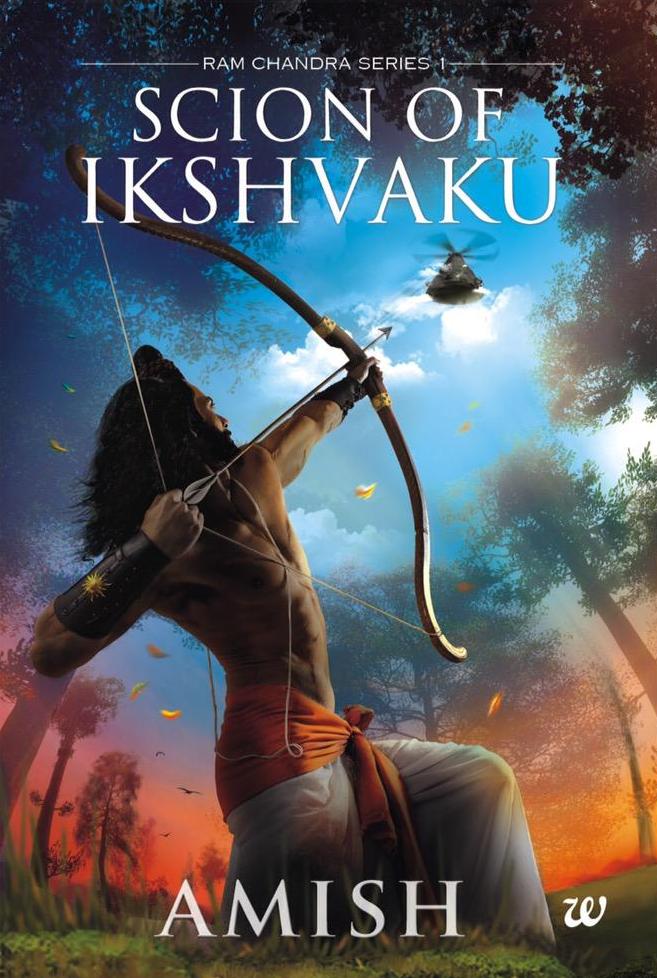
“He could have spent a lifetime being angry with the entire world. But he chooses to live a life of honour.” – Lakshman as he converses with Manthara’s Daughter in Scion of Ikshvaku.
Introduction
“India’s First Literary Popstar”, Amish Tripathi, has once again tried to weave the magic of unique storytelling, myth, history, profound philosophy, and beautiful emotions. This is the first book in the Ram Chandra Series and is adapted from the life of Lord Rama.
Ikshvaku was the founder of the Suryavanshi Dynasty, and Ram was one the scions of it. The book is a fictional interpretation of the various versions of Ramayana blended with historical theories and Amish’s own creativity. He traces the journey of Ram, the son of Dashrath and the founder of what is known today as Ram Rajya, the perfect empire. However, one is awed and shocked by the way Amish narrates the Ram Chandra Series with a complete deviation from traditional Ramayana.
To enjoy the book, one must suspend beliefs in Ram or any particular religion for the epic has been completely bended and narrated with a great imagination.
Reflection of Modern Indian Society
Ever since the announcement of the release of the book and the beginning of the promotional drive of the book, the readers have been waiting with baited breath for this book. However, those who were expecting the book to be another version of Ramayana or have read even a part of Ramayana should be ready for a surprise. Since ages various authors and poets have taken the liberty to narrate Ramayana in their own way. Amish have also used this liberty in weaving a Ramayana which brings out the evils of society.
Amish’s Ram is a tortured and ostracised prince who becomes a great king and then a God. Further, the kingdom of Ayodhya in the book seems to be a reflection of modern India as he quotes, “Crime rates were high, law and order was abysmal, and most rich maintained their own personal security set-up. The poor suffered terribly as a result.”
Additionally, the kingdom of Ayodhya is weakened after a terrible war and the demon King Ravana, imposes his trade instead of his rule on the defeated kingdom. The money is sucked out of the kingdom of Ayodhya. The author has uniquely blended the evils of our society in the novel while etching the character of Ram. For example, the gang rape scene reminds one of Nirbhaya, the caste system becoming a threat to society, the matter of polygamy, widespread corruption, law disorder etc. Unlike, Devdutt Pattnaik’s Sita, the book is a complete re-modelling of Ramayana. Though Amish innovation and creative skills are at their best but one element, particularly Sita’s Swayamwar becomes a bit hard to digest.
Shiva Trilogy vs Rama Chandra Series
Just like The Immortals of Meluhas, this book is set in the vedic period, narrating the tale of vedic people whose culture began more than 12,000 years ago and was destroyed 3,500 years ago. In Meluhas, the charismatic Shiva was a normal human being who rose to the level of god through his Karma. In the new series, Ram is an unloved prince who turns into a great king and then into a God. Similar theme that each one of us has a potential god within us and our Karma raises us to that level of god runs through this series as well. However, in Meluhas, Amish explored the question, “what is evil?” and in this book, the prominent question explored is what an ideal society is. Similar to his previous books, Amish has connected the plot with the Nagas and the Vayuputras but Amish’s Ram is not as dynamic as Shiva. Again, there are various open ended questions and secrets in the book. The Scion of Ikshvaku, is excellent when it comes to character building, descriptions, writing style, innovation, and language when compared to the Shiva Trilogy.
Philosophical Element
A core philosophy runs through all the books written by Amish and the story serves as a medium to convey it. Since Amish believe in the theory of Karma, he conveys it in a subtle manner, when he quotes, “Birth is completely unimportant. It is just a means of entry into this world of action, into this Karmabhoomi. Karma is all that matters.” Through his philosophy he triggers his readers to think unlike giving a message. The book is full of profound thoughts on various aspects such as marriage, caste, god, religion etc. The philosophy is inspired from Indian Scriptures and Amish discusses in detail the masculine and feminine way of life. Also, the concept of Ekam is something we have grown up with that there is only one god. The philosophical element has become a trademark for Amish’s works.
Conclusion
With his fast paced narrative, Amish once again keep his readers glued till the end. The book though does not have a literary merit but the wildly deviant plot spun around familiar mythological tales is an excellent display of Amish’s ingenuity. Overall, he meets the expectations of his readers and is certainly set to make another best-selling record.
Nice post..I love his books..somtimes i feel they get too long
Ananya Fashions and More
Reading it currently and agree with your review.
Was hesitant to pick it as Ramanyan story is well known. Questions raised are so true even in todays time. Conflict during Roshni’s death, not acceptance by father are so beautifully shown.
Keep writing about my favorite topics!! Thanks..
Very nice review… That’s exactly how I feel ?
Really very nicely you have written the review with all its different parts introduction , comparison , conclusion , etc. Totally amazing !